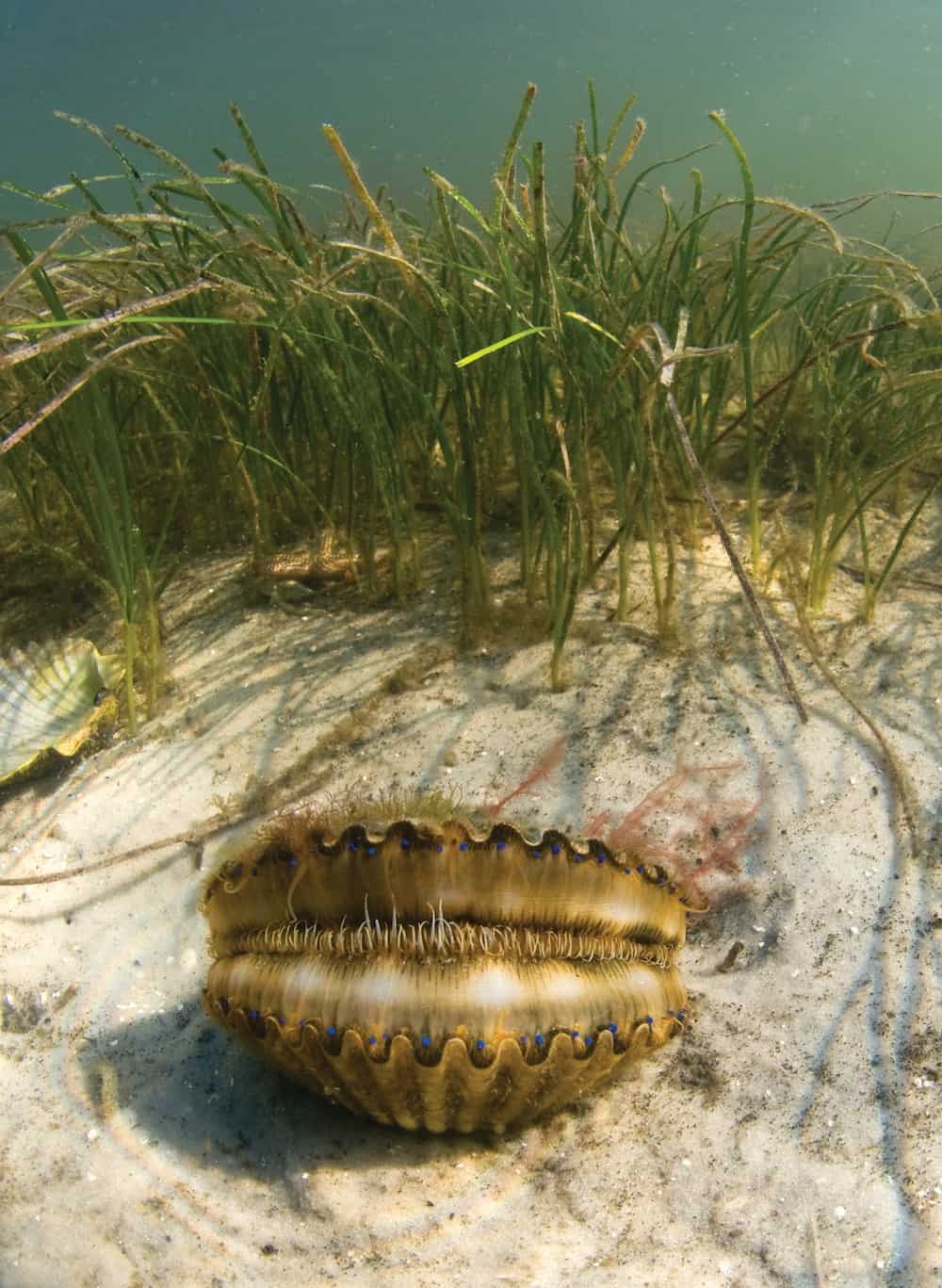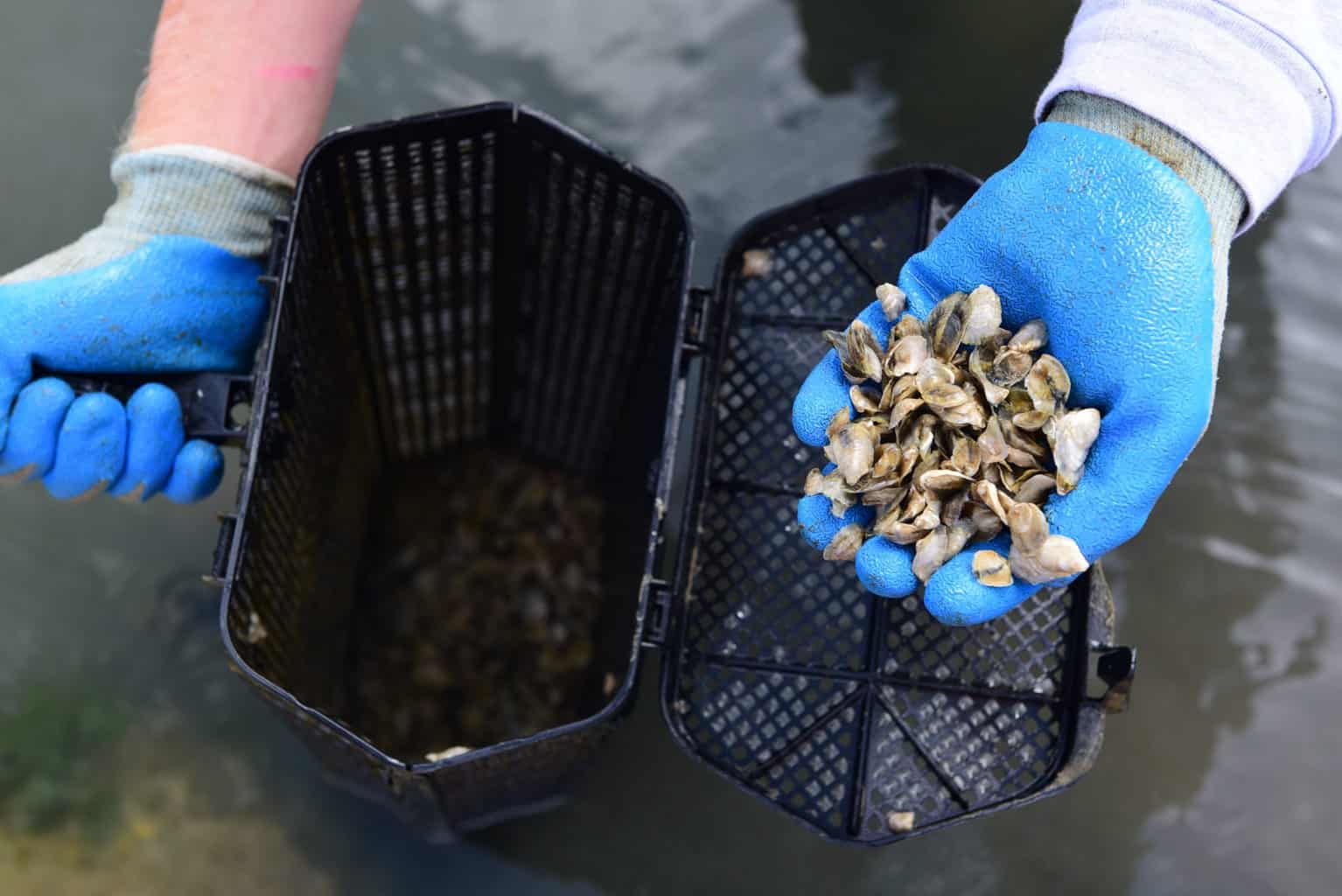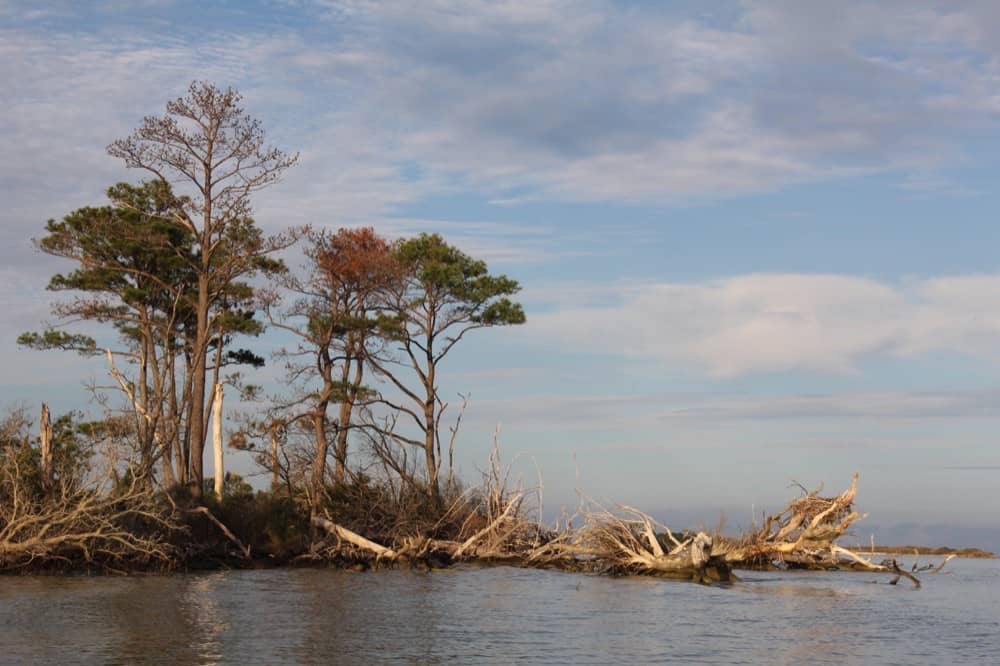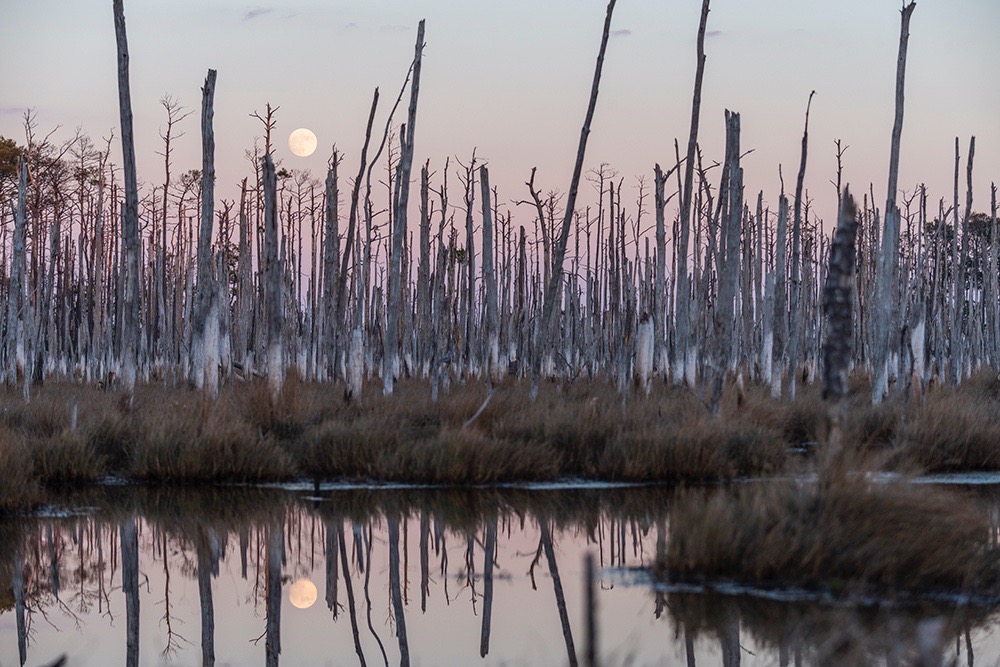Photo by Jay Fleming
Virginia scientists strive to re-establish an Eastern Shore coastal delicacy.
By Marty LeGrand
For an unendingly sunny summer day, the waters of coastal Virginia’s South Bay are bracingly cool. They’re also approximately the color of mop water—a problem when you’re diving to locate a bottom-dwelling creature that’s small, mobile and hasn’t been found in abundance here in nearly a century. Complicating matters, we’re searching by feel alone, pawing beds of clingy seagrasses frequented by stingrays, sea nettles and cranky blue crabs.
It makes for an exhilarating biological treasure hunt—even if I do feel a bit like Harry Potter exploring a shallow version of that creepy, Triwizard Tournament lake.
We’re searching for Argopecten irradians, the Atlantic bay scallop, a delicacy that once supported a significant commercial fishery in Virginia, wiped out long ago by habitat decline and a powerful coastal storm. Disease began claiming the seaside bays’ underwater grasses by the early 1930s. Then calamity struck.
In August 1933, the Chesapeake-Potomac Hurricane unleashed 80 mile-per-hour winds and a devastating storm surge on the Eastern Shore of Virginia’s barrier islands, destroying grass meadows in waters where local watermen made their living. Farther north, the storm cleaved the Ocean City Inlet. Without vegetation to shelter and sustain them, scallops disappeared and never returned. Soon, the barrier islanders left as well.
The Virginia Institute of Marine Science Eastern Shore Laboratory, a research and teaching institution in Wachapreague, has mounted an ambitious effort to spawn and raise bay scallops in hopes of creating a stable population in the same southern bays where they once flourished. The first broodstock was placed in South Bay nine years ago. Millions more scallops have joined them since. Each July, teams of scientists, students and volunteers go diving to see how the scallops—a notoriously finicky and vulnerable species—are faring in the wild by estimating how many have survived.
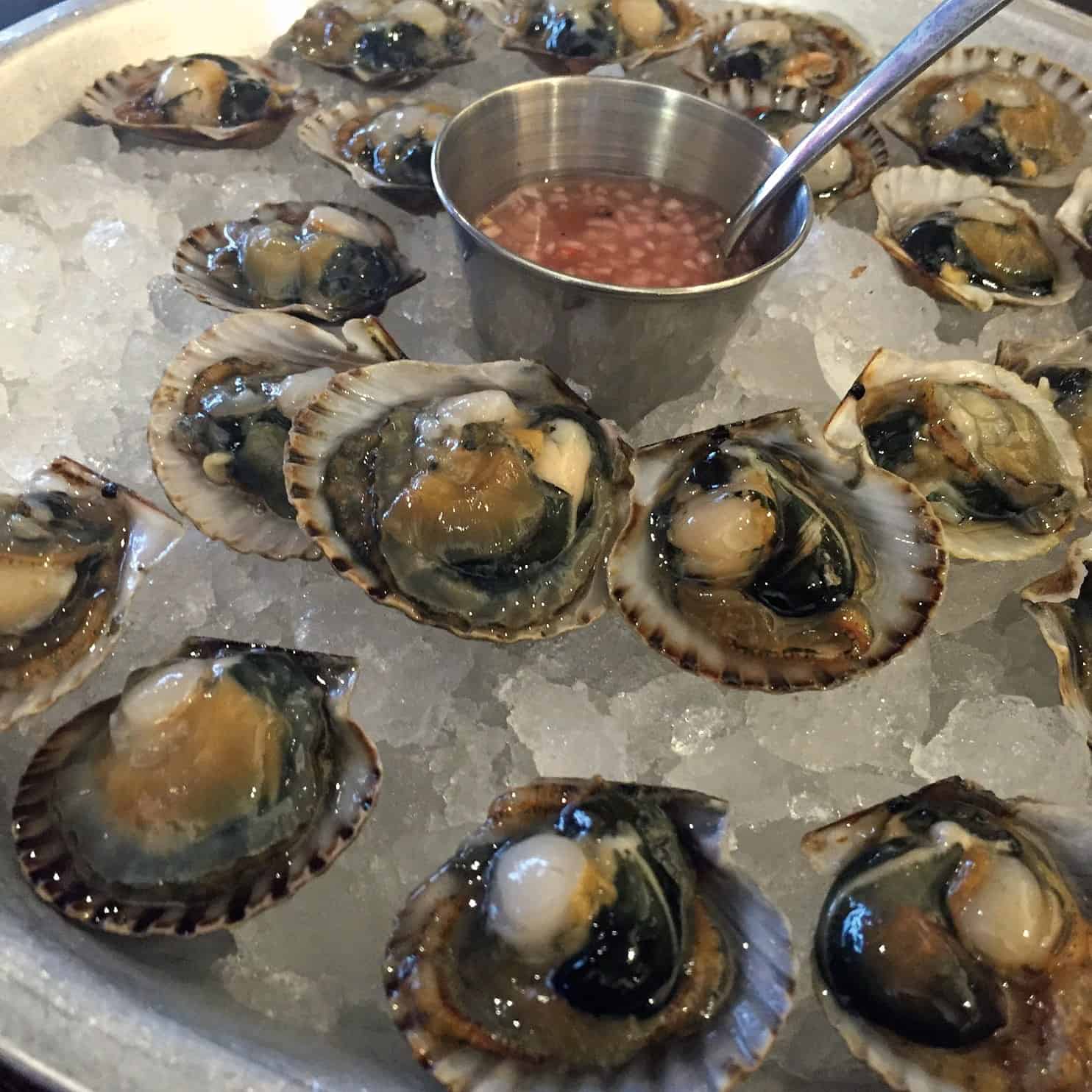 Photo by Rappahannock Oyster Co.
Photo by Rappahannock Oyster Co.
Richard Snyder is director of the Eastern Shore Laboratory and the scientist overseeing what he calls “bay scallop central,” one of the few facilities in the country culturing the mollusks from larvae to adulthood. I met him two months earlier to learn about the program, whose mission is two-fold and difficult—develop bay scallops (which are a third the size of more familiar sea scallops) as an aquaculture species for the seafood market and try to reintroduce them to the salty bays where they lived until, suddenly, they didn’t.
Bay scallops’ preferred home is among the eelgrass where they cling to its long, ribbon-like leaves in infancy and then detach to hide on the bottom as adults among the grasses’ thick roots. In 1930, Virginia watermen caught more than a million pounds of them. After the 1933 storm struck, the harvest plunged to zero.
Today, the 14 fragile islands that buffer Virginia’s Eastern Shore from the wild Atlantic are among the most remote places on the East Coast, so vital to marine life and shorebirds they’re permanently preserved as wildlife sanctuaries. The United Nations designated a 45,000-acre tract a biosphere reserve, a fancy title bestowed on unique ecosystems worthy of protection and scientific study.
Visitors will find two distinct worlds here. There are the barrier islands, constantly shape-shifting sand masses stretching southward from Chincoteague near the Maryland border to the tip of the Delmarva Peninsula. Desolate and seasonally storm-battered, they form the peninsula’s windswept outer ramparts. Behind these barriers lie tranquil coastal bays (lagoons) divided by acres of ocean-flushed marshes (some extensive and elevated enough to be called islands), which rise and fall with each tide cycle.
In 1997, scientists discovered two small patches of seagrass—an area no bigger than a bath towel—growing in South Bay. It was Zostera marina—eelgrass. Led by VIMS researcher Robert Orth, scientists at VIMS’s main campus in Gloucester Point and The Nature Conservancy began a program to reseed the vital grass species. Two decades later, that towel-sized patch has blossomed into an area three times bigger than the nearby town of Cape Charles. With 9,000 acres of eelgrass meadows growing once more in the bays, the scallops at least have a prayer of resurrection.
“The effort started down in the southern bays. South Bay, Spider Crab Bay and Cobb Bay have been restored with grass, and that’s where the [hatchery] scallops are going,” Snyder explained. The quick-spreading grasses were restored to a fourth, more northerly lagoon, Hog Island Bay, but conditions there don’t yet favor scallops. Like oysters, bay scallops are filter feeders, so restoring their numbers benefits water quality and seagrass growth.
With reddish-blond hair and well-freckled face and arms, Snyder looks the part of a field biologist and former Floridian. (He previously taught at the University of West Florida in Pensacola.) As a kid, he often spent summers on New Jersey’s Long Beach Island, a barrier island where his grandparents owned a beach house and where he learned about the animal he’s trying to rescue.
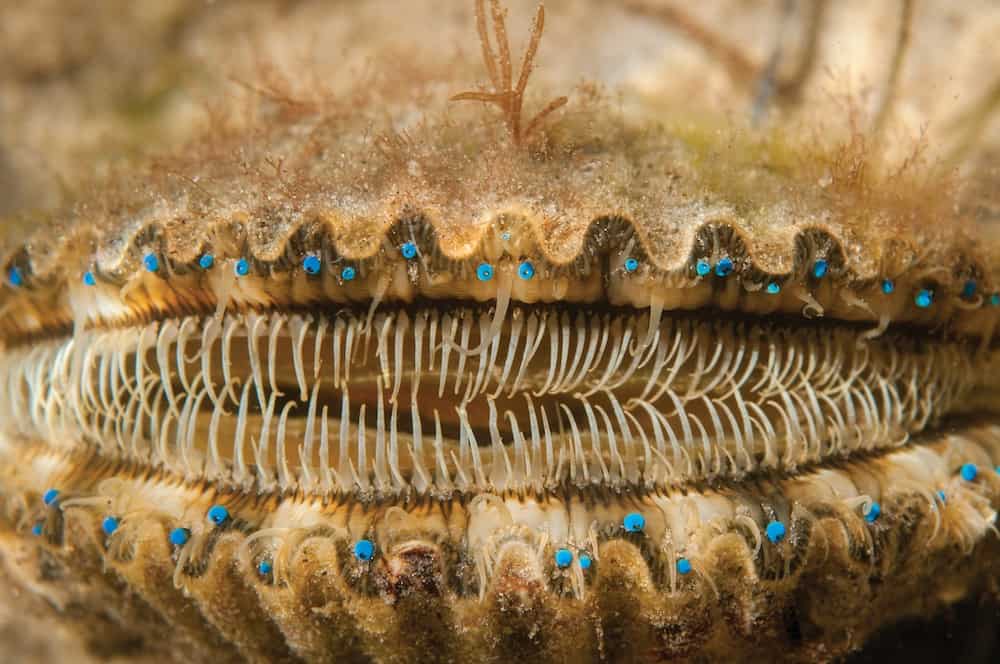 Photo by Jay Fleming
Photo by Jay Fleming
“I remember playing around in the eelgrass beds on the bay side. My grandmother’s walking around, looking,” he told me. “Whatcha doing?” he asked her. “Looking for scallops,” she replied. “When she was younger, they used to be able to catch them and eat them. But when I was a kid they were gone,” he said. “They had just disappeared.”
New Jersey, Virginia, Maryland—nearly all of the East Coast—has seen bay scallop populations collapse since the 1980s. Massachusetts and New York have the only remaining commercial fisheries. Florida permits a recreational fishery. North Carolina did too until recently, when the population could no longer sustain itself.
Compared with oysters, hard clams and other mollusks, bay scallops are milquetoasts. They can’t tolerate extreme temperatures. They grow only in high-salinity waters and readily fall victim to algal blooms, their 1980s downfall. They dislike swift currents and overcrowding. Their average lifespan is just 18 months. And almost everything eats them.
Snyder recited a partial list of predators: “Skates really like them. Some of the drum will eat them. Birds will eat them. Crabs will eat them.” For that reason, when VIMS’s hatchery-raised scallops are ready to grow up in the wild, they’re often kept in cages. The strategy mostly works.
“Octopuses can wipe out whole cages,” Snyder said. “One year we had an octopus in a cage. We ended up with one fat octopus and no scallops.” During regular cleanings, the cages are also de-predatored when necessary.
Snyder gave me a tour of the Wachapreague lab’s Castagna Shellfish Research Hatchery. Named for the father of VIMS bay scallop research, Mike Castagna, the hatchery is the heart of the scallop restoration effort. Here, scallops are spawned twice a year (spring and fall) in an indoor hatchery. Larvae are then transferred to the nursery, an outdoor facility next to the hatchery, where they grow into juveniles.
Castagna first experimented with scallop aquaculture in the 1960s, but it was Snyder’s immediate predecessor as lab director, Mark Luckenbach, who began the restoration effort after Castagna’s death in 2004. “He went down to North Carolina, got a couple hundred scallops, and started raising them here in the hatchery specifically for restoring them to the seagrass beds,” Snyder said.
The Wachapreague hatchery is unusual among scallop growers. “Most of the hatcheries in New England that produce bay scallops release the larvae,” Snyder explained. “They don’t grow them up to juvenile size.” Hatcheries are labor-intensive and therefore costly operations. And hatchery scallops are no less finicky than wild ones.
I visited the lab in early May to coincide with the large spring spawn. But the feckless scallops were being stubborn. Inside the hatchery, a compact, weathered-wood and cinder-block building, manager Rebecca (Reba) Turner Smith explained the inherent whimsy of scallop sex. She pointed to a shallow, water-filled tank where several dozen sexually prime scallops lay idly on the bottom. Occasionally, one released a small puff of water and spun around. A few of their kind spawned last week, Turner Smith said, but this group weren’t so inclined.
On her smart phone, she showed me a video of the act. Scallops are hermaphrodites, capable of producing both eggs and sperm. In the video, one scallop could be seen releasing a small, milky-white cloud of sperm. Gradually, other scallops joined in, emitting their own opalescent fogs.
“Whenever one goes off, it stimulates the others and they start releasing gametes,” Snyder explained. To avoid self-fertilization, the scallops release sperm and eggs separately, starting with their sperm.
“Sometimes they’ll take right off, but sometimes they’re a little stubborn and they need a little coaxing,” Turner Smith said. Increasing or decreasing the water temperature slightly usually gets them in the mood. Tongue in cheek, Snyder proposed another inducement: “Sometimes you have to light some candles and put some music on.”
Turner Smith laughed. “Yep, a little Barry White.”
Snyder plopped one of the listless bivalves in a beaker of water for closer inspection. Attached to their distinctive round, corrugated shells, bay scallops have two triangular flanges on either side of the shell hinge, like a tiny bow tie. The shells appear in a variety of colors, but are uniformly small, no wider than about three inches.
The most distinctive and intriguing part of scallop anatomy—visible only up close—are tiny, steel-blue eyes. Up to 30 of them peer from the perimeter of the scallop’s upper and lower shells as it watches for danger—for example, several large humans examining it through a beaker.
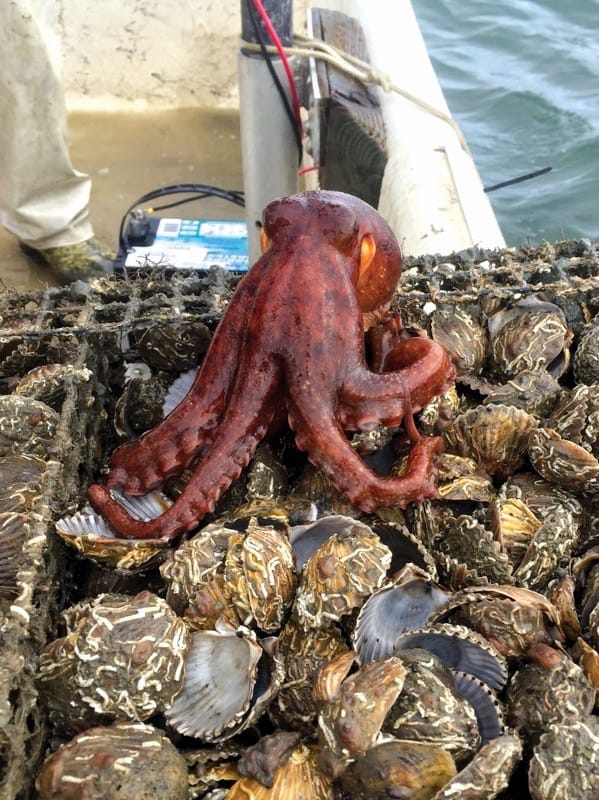 An octopus can wipe out an entire cage of bay scallops, which are vulnerable to all kinds of predators. (Photo: Virginia Institute of Marine Science)
An octopus can wipe out an entire cage of bay scallops, which are vulnerable to all kinds of predators. (Photo: Virginia Institute of Marine Science)
“It’s a really amazing eye. It’s like a mirror-reflex lens on a camera,” Snyder said. Intriguing, too, because the animal has no brain with which to process the images. When scallops detect shadows cast by predators, they escape using jet propulsion, rapidly clapping their shells together to emit bursts of watery thrust from the shell cavity. Tiny tentacles along the shell opening also allow them to sense and react to their environment.
Once the scallops are induced to spawn in the hatchery, their microscopic larvae remain for 10 days—sipping a diet of cultured algae—before being transferred to the nursery. There, these free swimmers quickly attach to vertical slats, the plastic equivalent of eelgrass leaves, in tables filled with seawater pumped from Wachapreague Channel.
The hatchery can house as many as four million larvae. A small minority survive—another impediment to viable scallop aquaculture. “If we get ten percent [survival] we’re ecstatic,” Snyder said. “It can be anywhere from zero to ten percent, and five is pretty normal.”
Larvae are also prone to fleeing. Nursery manager Darian Kelley said she constantly removes would-be escapees from the tables’ filters during daily cleanings performed for the duration of the tiny scallops’ stay in the nursery, between 30 and 50 days. “You have to drain these tables down, rinse them with saltwater and then rapidly refill them before the scallops dry out,” she said.
When the juveniles grow big enough not to elude 2-millimeter mesh bags, they can be bagged, placed in bottom cages and deployed to the restored grass beds. The lab maintains a stock of 20,000 to 30,000 scallops in South Bay for breeding purposes. In a productive year, the hatchery/nurseries’ graduating classes number far higher—400,000 in 2017—enabling non-broodstock scallops to be set free to reproduce in the wild. Since 2010, the lab has released nearly 14 million larvae, 940,000 juveniles and 209,000 adults, enhancing scientists’ efforts to reach a thus-far elusive objective.
“Getting a stable population with a short-lived critter is difficult,” Snyder conceded. “Our goal is to get a population out there so we can sustain a recreational harvest. We’re about tenfold below the harvest threshold that Florida uses. So we’ve got a ways to go.”
The July survey tells them how well they’re doing. Divers in four or five boats spend several days painstakingly searching the bays for scallops. “By the time we’re done,” Snyder said, “we’ve put our hands on four acres of seagrasses and count all the scallops to get an idea of how many are out there.”
I volunteered (vaguely) to help, an offer I was reminded of in a VIMS email months later. “It’s one of the coolest projects we work on each year,” wrote Sean Fate, watercraft operations manager.
Which is a long way of explaining how, on the survey’s first day, I find myself on the VIMS skiff with Snyder and two biology students: Eli Turner, who’s participated in two previous surveys, and Danielle Olive, an intern from the University of the Virgin Islands eagerly joining her first. We’re in the middle of South Bay, the largest southern lagoon, where the only features preventing bay and sky from blending seamlessly are distant ribbons of saltmarsh and sand dune. To our west lies Mockhorn Island Wildlife Management Area, a marshy former pirate hideout and hunters’ retreat. To our east, Wreck Island, a barrier isle that shifting dunes conjoined with ex-neighbor Bone Island over the years.
Turner rides in the bow, ready to drop the anchor at 25 or so survey sites Snyder has marked on a chart segment clipped to the windshield. Each diver searches using a one-meter-square frame of submersible PVC pipe. We push the quadrat (as it’s called) toward the bottom, take a deep breath and dive after it.
It’s 75 degrees on the surface, but the water feels far chillier through our thin wetsuits. The bay is shallow—chest height at its deepest—yet scuba masks become useless for seeing through its suspended sediments to the bottom. The salinity is so high—seawater strength—we struggle to remain submerged, even wearing a diver’s belt.
The work is rhythmic, peaceful and addictive. We’re told to flatten our palms and pat the quadrat area with gloved hands to locate even the smallest scallops. The eelgrass feels dense and gangly, its leaves thick as fettuccine. Shells are plucked like trophies from the sand.
When we’ve covered one square meter, we flip the quadrat forward and dive again until the group has covered 50 quadrats per site. We return our finds of live or dead scallops as well as blood clams (an edible member of the ark family) to the skiff, to be measured and recorded along with an estimate of eelgrass density.
At the 24th dive site, after nearly six hours of surveying, Snyder finds our first and only live scallop. We recover six dead ones, victims perhaps of those rays that occasionally swim past the skiff. (Thankfully, none of us endures a painful critter encounter.) We return to shore by late afternoon.
The results of last summer’s survey: 81 live scallops retrieved from three coastal bays for an estimated 2018 abundance of 70,000 scallops. It was an especially disappointing year in South Bay, which recorded
its lowest numbers of the last seven surveys.
“There are two things that pop out to me as problematic,” Snyder says of the population’s vexing instability. “Predation is certainly one. It could be genetics, too.” To diversify and strengthen the stock, he says the lab introduces scallops from other states.
Virginia’s scallops also may be too dispersed for successful procreation. “The problem with spawning when the numbers are so low is they can’t find each other,” Snyder says. In the confines of the hatchery at least, even the most recalcitrant scallops fertilize themselves eventually.
So, for now, scientists at bay scallop central will keep tweaking the gene pool, adjusting the thermostat, playing mood music and doing whatever it takes until the bivalves are able to thrive once more in their ancestral home.

